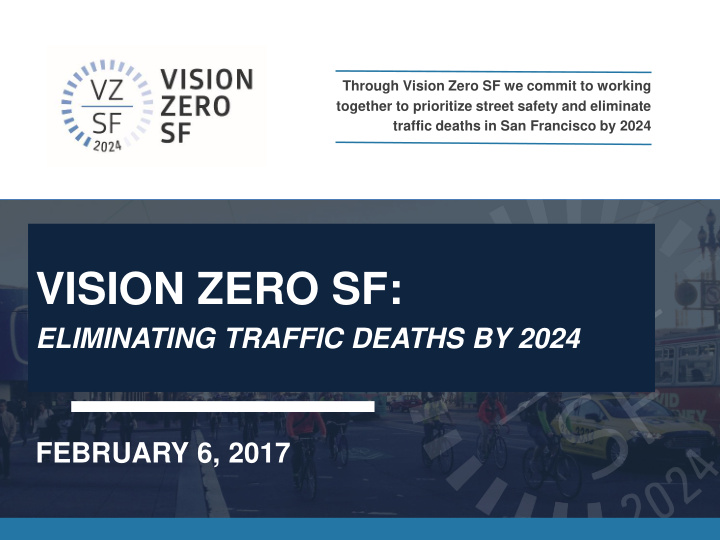



Through Vision Zero SF we commit to working together to prioritize street safety and eliminate traffic deaths in San Francisco by 2024 VISION ZERO SF: ELIMINATING TRAFFIC DEATHS BY 2024 FEBRUARY 6, 2017
VISION ZERO VISION ZERO SF 101 Create “safe system” Core Principles using data-driven approach – 1. Prevention 2. Saving Lives A transportation system — streets and 3. Equity programs/policies — that 4. Safe Streets, Safe anticipates human error People , Safe Vehicles such that mistakes do 5. Reduce Speed not result in death
4 VISION ZERO ADOPTION TO TODAY February 2014: San Francisco adopts VZ policy, committing to eliminate traffic fatalities by 2024 City ahead of schedule for 24 projects in 24 months
VISION ZERO Geneva/Cayuga Signal, Safer Market Street, $1.1M $450k Tenderloin Daylighting (red curbs), $150k 19 th Ave Corridor Signal Timing (Sloat-Junipero Serra), $46k Lombard Street Safety Project, $12M
6 VISION ZERO CAPITAL PROGRAM INFORMED BY VISION ZERO HIGH-INJURY NETWORK 70 % of severe and fatal traffic injuries occur on just 12 % of San Francisco streets. Implement at least 13 miles of treatments prioritized by the high-injury network and vulnerable populations Implement treatments programmatically citywide
VISION ZERO NEAR TERM CAPITAL INVESTMENT IN VISION ZERO ($B) • While projects are informed by the high injury corridor (HIC), a wide $3.4B $3.5 $3.3B range of capital projects beyond the HIC also support the policy goal of VZ $3.0 Central • Subway In terms of work specifically focused $2.5 on the HIC, Safer Streets • SFMTA’s FY17 -21 Capital 40% Improvement Program (CIP) $2.0 Transit Optimization/ plans to invest ~$190M Expansion • The FY 17+18 Capital Budget $1.5 plans to invest ~$70M $1.0 • Example projects/programs State of Good Repair supporting Vision Zero include: 6 th Fleet Fleet Street Streetscape, Glen Park $0.5 Transportation Improvements, Traffic Calming Program, New Pedestrian $0.0 Countdown Signals, Van Ness BRT, 22 FY 17-21 CIP FY 15-19 CIP Fillmore 16 th Street Transit Priority
VISION ZERO BY 2024 Address the entire High-Injury Network : • 2014: treated approximately 10 miles • 2015: treated approximately 20 miles • 2016: 13+ miles HIN analysis is iterative Complete gap analysis so Capital Improvement Plan supports reaching annual targets
VISION ZERO ACKNOWLEDGEMENTS SFDPW Port Controller’s Office SFDPH Planning SFCTA Rec & Parks SFUSD Mayor’s Office SFE Mayor’s Office on Disability SFO District Attorney’s Office SFPD SFPUC BOS SFFD City Administrator's Office
VISION ZERO QUESTIONS Mari Hunter Senior Transportation Planner Co-Chair, San Francisco Vision Zero Task Force San Francisco Municipal Transportation Agency Mari.Hunter@sfmta.com
Recommend
More recommend